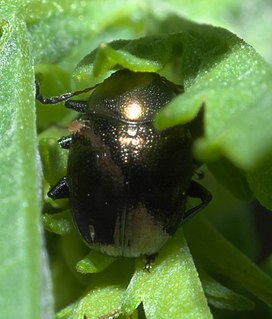
The Eumolpinae are a subfamily of the leaf beetles, or Chrysomelidae. It is one of the largest subfamilies of leaf beetles, including more than 500 genera and 7000 species. They are oval, and convex in form, and measure up to 10 mm in size. Typical coloration for this subfamily of beetles ranges from bright yellow to dark red. Many species are iridescent or brilliantly metallic blue or green in appearance.
Samarendra Nath Maulik was an Indian entomologist who worked at the Natural History Museum, London and specialized in the systematics of the leaf beetles. He worked briefly at the University of Calcutta as a professor of Zoology. A structure on the hind femur, particularly of flea beetles, and used in their leaping motion has sometimes been called as "Maulik's organ".

Rhembastus is a genus of leaf beetles in the subfamily Eumolpinae, native to Africa. Whilst the taxonomy of the genus is disputed, the genus has been suggested as a biological control agent for Bryophyllum delagoense in Australia.
Bikasha is a genus of flea beetles in the family Chrysomelidae. There are 19 described species from the Seychelles and the Oriental realm.

Paraivongius is a genus of leaf beetles in the subfamily Eumolpinae. It is distributed in Africa.

Eumolpini is a tribe of leaf beetles in the subfamily Eumolpinae. It is the largest tribe in the subfamily, with approximately 170 genera found worldwide. Members of the tribe almost always have a longitudinal median groove on the pygidium, which possibly helps to keep the elytra locked at rest. They also generally have a subglabrous body, as well as appendiculate pretarsal claws.

Demotina is a genus of leaf beetles in the subfamily Eumolpinae. There are over 50 described species in Demotina. The genus is native to Asia, Australia and Oceania, though one species is an adventive species in the southeastern United States in North America. Some species are known to be parthenogenetic.

Typophorini is a tribe of leaf beetles in the subfamily Eumolpinae. The tribe contains approximately 100 genera, which are found worldwide. Members of the tribe are mainly characterized by notches on the tibiae of the middle and hind legs, which are sometimes referred to as antenna cleaners. They also generally have a subglabrous body, as well as bifid pretarsal claws.
Hyperaxis is a genus of leaf beetles in the subfamily Eumolpinae. It is distributed in East and Southeast Asia.

Rhyparida is a genus of leaf beetles in the subfamily Eumolpinae. It is distributed in the Australasian and Indomalayan realms, though some species are also known from the African islands of Madagascar and Seychelles.

Abirus is a genus of leaf beetles in the subfamily Eumolpinae. It is distributed from the Malay Archipelago to the Indian subcontinent, China, and the Ryukyu Islands. The genus was first established by the Belgian entomologist Félicien Chapuis in 1874, as a split of Dermorhytis.
Chloropterus is a genus of leaf beetles in the subfamily Eumolpinae. It is distributed in Eastern Europe, West to Central Asia and North Africa.
Eka nigra is a species of leaf beetle endemic to Silhouette Island in the Seychelles, in the low country near the coast, and the only member of the genus Eka. The species was first described by the Indian entomologist Samarendra Maulik, from a specimen collected by the Percy Sladen Trust Expedition to the Indian Ocean in 1908. The generic name comes from the Sanskrit word एक (éka), meaning "single", "alone". The genus is related to Trichochrysea.
Stethotes is a genus of leaf beetles in the subfamily Eumolpinae. It is distributed in Southeast Asia and the Western Pacific.

Dematochroma is a genus of leaf beetles in the subfamily Eumolpinae. It is mostly distributed in New Caledonia, though it is also found on Lord Howe Island, Norfolk Island and Timor. Adult beetles are often found at night feeding on leaves, and the larvae eat roots. It is possible the genus is polyphyletic or paraphyletic.
Scelodonta is a genus of leaf beetles in the subfamily Eumolpinae. The genus includes over 70 species, mainly from the Afrotropical, Palearctic and Oriental biogeographic realms. Only three species are found in Australia.

Fidia is a genus of leaf beetles in the subfamily Eumolpinae. It is distributed in East Asia, Southeast Asia and Africa.

Bromiini is a tribe of leaf beetles in the subfamily Eumolpinae. The tribe contains approximately 120 genera, which are found worldwide. They are generally thought to be an artificial group, often with a subcylindrical prothorax without lateral ridges and covered with setae or scales.
Stygnobia is a genus of leaf beetles found in the Samoan Islands and Fiji. It is a member of the subfamily Eumolpinae.










